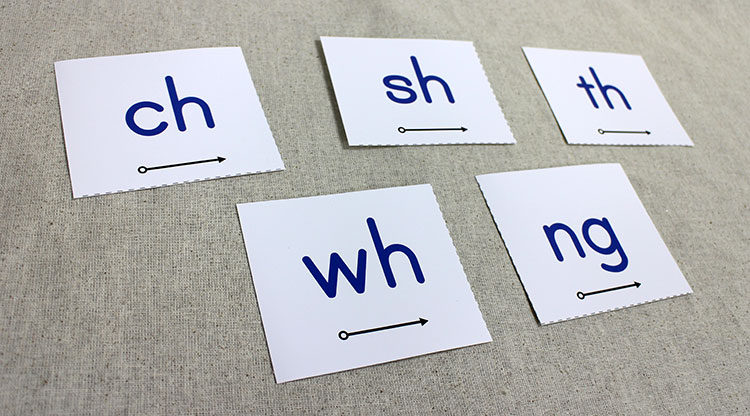I 3: Quick Pick
1. Overview
Make a game of identifying the “special sound” (digraph) in each of a variety of words.
I3: Quick Pick
2. Materials & Preparation
- Script
- word list (same as for the previous two activities)
- sound cards for the digraphs — with dotted lines (same as for the previous two activities)
- sound cards for the digraphs — without dotted lines
3. Activity
Video: How to play Quick Pick
Put out all the digraph sound cards in front of the child. (Put the cards without dotted lines in a propped-up row, with the dotted-line cards in a row beneath them.) Using the provided word list, give the child one word at a time. He will repeat the word, make the sound and do the appropriate gesture for that digraph, and point to the correct sound card. He should then say the word one more time.
Adult: I’m going to say a word, and I want you to tell me which special sound you hear in that word. Get ready: shoe. Say that. Child: Shoe. Adult: That’s right. What special sound do you hear? Listen: shoe. Child: /sh/ Adult: Yes. What motion do we do for that sound? Child: [Makes “shh” gesture] /sh/ Adult: Now point to the sound card and say the word. Child: [Points to /sh/ card] Shoe. Adult: Good job! Let’s try another word. Listen: fang.Go through the words on the word list in random order. Give him a point for each correct answer. Make note of any words or digraphs the child struggles with, and revisit those words at the end. ↑ Top
4. Small Groups (2-5 children)
Lesson Objective: Using digraph sound cards, children will hear and repeat the digraph phoneme in a spoken word and match the digraph phoneme to its corresponding letter card. GELDS (Georgia Early Learning & Development Standards): CLL6.4f Georgia Standards of Excellence: ELAGSEKRF3.a Common Core State Standards: CCSS.ELA-LITERACY.RF.K.3.A Additional Materials:- optional: pocket chart or magnetic board with magnets, tape, whiteboard
Leave a Reply

One Response to “I 3: Quick Pick”
Tarra S
These are extremely helpful activities! I love them all!